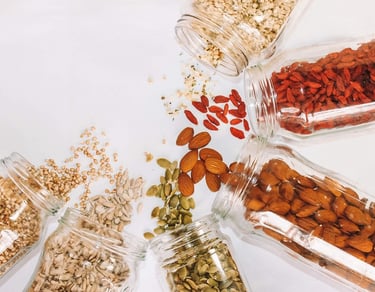Foods we don't eat enough of


Sometimes, when you're trying to correct your diet, it feels like you're only allowed vegetables and water ;) Fortunately, this is far from the case!
The important thing is to have a diversified diet. In principle, you can eat anything (except, of course, processed foods, which are ultra-denatured), as long as it's in the right quantities and as part of a wide range of foods.
There are many possibilities to broaden the range of foods we're used to eating. I bet we're going to put our finger on at least one food category that you don't usually eat: whole grains, tubers other than potatoes, oilseeds, seeds, sprouted seeds, legumes, nutritional yeast, chicken broth, sourdough bread, lacto-fermented vegetables, and spices.
So, let's open up the field a little more. Let's take oilseeds, for example: almonds, hazelnuts, pecans, Brazil nuts, cashews and so on. They can be eaten plain, but also in the form of purées or pesto’s. Purées can be spread on bread or added to yoghurt, or a breakfast based on oat flakes and plant milk. A little honey can be added if sweetening is required. Pesto’s are prepared by mixing an oilseed with a vegetable such as radish tops, a seasoning such as lemon juice, and olive oil. It can also be spread on bread or added to a dish or salad.
All the foods listed above are interesting from a nutritional point of view: wholegrain cereals provide the fiber that their refined versions lack; parsnips, a tuber, are rich in antioxidants, minerals and vitamins; sweet potatoes, another tuber, have a low glycemic index (GI) compared to potatoes; oilseeds are an excellent source of fatty acids, minerals, vitamins, vegetable proteins and fiber; idem ditto for seeds, not to mention that sprouted seeds are concentrates of micronutrients. Sourdough bread and lacto-fermented vegetables contain bacteria that are excellent probiotics for our intestines. Real chicken broth, the kind you make yourself, is rich in glucosamine and chondroitin from cartilage, for the benefit of our joints. It's also rich in glycine, one of the three amino acids that make up the major antioxidant glutathione, which is often lacking in our current diet. Finally, nutritional yeast is rich in protein, B vitamins, minerals, choline (useful for methylation) and glutathione, and has antiviral and antibacterial properties. Oh, yes, I forgot about legumes: they have a low GI and are rich in vitamins, minerals, fiber, and proteins.
Be careful, however, to prepare these foods correctly. Legumes, wholegrain cereals, oilseeds, and seeds need to be soaked. The minimum soaking time varies from one to another, but to save myself the trouble, I soak them overnight in a large volume of water in the fridge. The soaking water should be discarded, as it contains the undesirable substances we're trying to get rid of: in simple terms, phytates in the case of legumes and oilseeds. Soaking also increases the digestibility of these foods, enabling us to absorb more of their nutrients. Note that some people claim that it’s better to ingest those substances to benefit from their strengths. I’m personally not so convinced. As an alternative to soaking, oilseeds and seeds can be lightly toasted.
To find out more, also read these articles:
On the issues of industrial foods: https://isabellemaesnutrition.com/en/processed-foods
Oilseeds picture by Maddi Bazzocco
